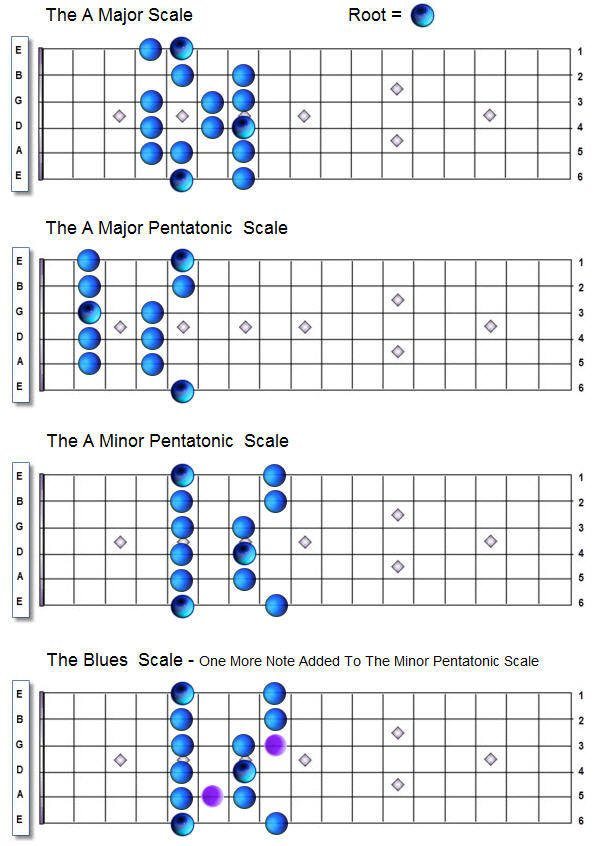Have you ever felt like your fingers are doing the guitar-excellence-inspirational-stories-to-fuel-your-musical-journey/” title=”Pathway to Guitar Excellence: Inspirational Stories to Fuel Your Musical Journey”>cha-cha instead of smoothly gliding up and down the scales-important-top-reasons-revealed/” title=”Why are Guitar Scales Important? Top Reasons Revealed”>fretboard? Are your attempts at playing guitar scales coming out more like a toddler banging on pots and pans? Fear not, dear reader, for we are here to guide you through the magical world of mastering guitar scales. Get ready to unlock those advanced skills and become the smoothest shredder on the block – because let’s face it, who doesn’t want to impress all the cool cats at the guitar jam sessions? Let’s dive in and unleash your inner guitar god!
Contents
- 1 Exploring the Diversity of Guitar Scales: A Gateway to Musical Expression
- 2 The Role of Muscle Memory in Mastering Fretboard Navigation
- 3 Incorporating Scale Exercises into Daily Practice Routines
- 4 Decoding Patterns: The Major and Minor Pentatonic Scales
- 5 Unlocking the Secrets of the Modes: Dorian, Phrygian, and Beyond
- 6 Advanced Techniques: Speed Picking and Legato within Scale Frameworks
- 7 From Practice to Performance: Applying Scales in Musical Contexts
- 8 FAQs
- 9 Rock On and Keep Shredding!
Exploring the Diversity of Guitar Scales: A Gateway to Musical Expression
Let’s dive into the wacky world of guitar scales, where notes go to party and musical expression reigns supreme! Forget about your basic major and minor scales, we’re about to take a wild ride through the diverse and quirky scales that will make your guitar playing truly stand out.
First up, we have the Phrygian scale, the black sheep of the family. With its exotic and mysterious sound, the Phrygian scale will transport you to far-off lands and make your listeners wonder where in the world that magical music is coming from. It’s perfect for adding a touch of spice to your solos and improvisations.
Next, let’s explore the Lydian scale, the eccentric uncle of the guitar scales. With its raised 4th degree, the Lydian scale has a dreamy and ethereal quality that will make your melodies soar to new heights. Embrace the weirdness of the Lydian scale and watch your music take on a whole new dimension.
And finally, we have the Mixolydian scale, the laid-back cousin that’s always down for a good jam session. With its bluesy and soulful vibe, the Mixolydian scale is perfect for adding a touch of groove to your playing. So grab your guitar, embrace the diversity of guitar scales, and let your musical expression run wild!

Have you ever wondered how some guitarists seem to effortlessly navigate the fretboard while others struggle to remember where to place their fingers? The secret lies in muscle memory – that mystical force that allows you to play complex riffs and solos without even thinking about it.
When you first start learning guitar, your fingers feel clumsy and uncoordinated. But with practice, they start to remember the patterns and movements required to play different chords and scales. It’s like they develop a mind of their own, guiding you effortlessly from one fret to the next.
Mastering fretboard navigation is all about training your muscles to move in the right way at the right time. Whether you’re playing a simple three-chord song or a complicated jazz fusion piece, muscle memory is what allows you to execute each note with precision and confidence.
So next time you find yourself struggling to find the right fret, remember to trust in your muscles. They know the way – all you have to do is let them take the lead. And who knows, maybe one day you’ll be navigating the fretboard like a true guitar hero!

Incorporating Scale Exercises into Daily Practice Routines
Are you tired of practicing the same old scales in the same old boring way? Well, fear not my musical comrades, for I have the solution for you! Incorporating scale exercises into your daily practice routine doesn’t have to be a snooze-fest. With a little creativity and a touch of pizzazz, you can turn those mundane scales into a fun and exciting part of your day.
One way to spice up your scale exercises is to add some variety to your practice routine. Instead of playing the same old scales in the same old order, mix things up a bit! Try playing your scales in a different key each day, or throw in some unconventional scales like the Hungarian minor or the whole tone scale. The possibilities are endless, so get creative and have fun with it!
Another fun way to incorporate scale exercises into your daily routine is to turn them into a game. Set a timer and see how many scales you can play in a minute, or challenge yourself to play a certain scale pattern backwards. You can even make a game out of memorizing the circle of fifths by playing scales in a specific order. The key is to make practicing scales engaging and enjoyable, so don’t be afraid to get a little silly with it!
So there you have it, my friends. With a bit of imagination and a sprinkle of silliness, you can transform your scale exercises from a chore into a joy. So go forth and conquer those scales with gusto and flair, and let the music magic flow through you!

Decoding Patterns: The Major and Minor Pentatonic Scales
So you’re learning about the major and minor pentatonic scales, huh? Well, buckle up because we’re about to take you on a musical journey filled with patterns, notes, and maybe even a little bit of confusion. But don’t worry, we’ll make sure you come out the other side a pentatonic scale pro!
First things first, let’s talk about the major pentatonic scale. This scale is like the popular kid in school – everyone loves it and it’s always hanging out with the cool chords. It’s made up of five notes that are carefully handpicked to create that sweet, harmonious sound that everyone can’t get enough of. So if you want to impress your friends at the next jam session, make sure you know your major pentatonic scale like the back of your hand!
Now onto the minor pentatonic scale. This scale is a little more mysterious, like that kid who always sits in the back of the classroom with their hood up. It’s got a darker, more soulful sound that can really tug at your heartstrings. Just like its major counterpart, the minor pentatonic scale is made up of five notes that work together in perfect harmony. So if you’re feeling a little moody and want to express yourself through music, the minor pentatonic scale is the way to go!

Unlocking the Secrets of the Modes: Dorian, Phrygian, and Beyond
So you want to dive deep into the mysterious world of modes, huh? Well buckle up, because we’re about to take a wild ride through the Dorian, Phrygian, and beyond!
First up, let’s talk about the Dorian mode. Picture this: you’re walking through a medieval village, the sun setting in the distance, as you play your trusty lyre in the hauntingly beautiful Dorian scale. The villagers are mesmerized by your musical prowess, as you transport them to a time long forgotten.
Now, onto the Phrygian mode. Imagine yourself descending into the depths of the underworld, as the eerie Phrygian scale sends shivers down your spine. You can almost hear Cerberus growling in the distance, warning you to tread lightly in this dark and mysterious realm.
But wait, there’s more! Beyond the Dorian and Phrygian modes lies a whole world of musical possibilities waiting to be explored. Mixolydian, Locrian, Lydian – the list goes on and on. So grab your instrument of choice, and let’s unlock the secrets of the modes together!
Advanced Techniques: Speed Picking and Legato within Scale Frameworks
So you’ve mastered the basics of guitar playing and now you’re ready to take it up a notch with some advanced techniques. Speed picking and legato are two essential skills that will help you shred like a rockstar within scale frameworks.
When it comes to speed picking, think of yourself as a human metronome. Practice alternate picking with precision and control to build up your speed gradually. Start slow and gradually increase the tempo, focusing on keeping a steady rhythm and clean technique. Before you know it, you’ll be flying up and down the fretboard like a pro.
Legato, on the other hand, is all about smoothness and fluidity. Use hammer-ons and pull-offs to create seamless connections between notes within a scale. The key here is to minimize the gaps between your notes, keeping the sound flowing effortlessly. With a bit of practice, you’ll be able to create those lightning-fast legato runs that will leave your audience in awe.
So grab your guitar, warm up those fingers, and dive into the world of speed picking and legato within scale frameworks. Remember, practice makes perfect, so don’t get discouraged if it takes some time to master these techniques. Before long, you’ll be wowing crowds with your lightning-fast licks and smooth legato lines.
From Practice to Performance: Applying Scales in Musical Contexts
So you’ve been diligently practicing your scales, running up and down the keyboard or fretboard like a musical madman. But now comes the tricky part – actually applying those scales in real musical contexts. Fear not, my fellow musicians, for I am here to guide you through this treacherous terrain with wit and wisdom (hopefully more of the former).
First things first, let’s talk about improvisation. This is where those scales really come in handy. Instead of just playing them in order, mix things up a bit. Skip around, throw in some spicy chromatic notes, and don’t be afraid to make a mistake (as long as it’s a cool mistake). Remember, jazz musicians have been faking their way through solos for decades, so you’re in good company.
Next up, let’s talk about creating melodic lines. Instead of playing scales robotically, try to think melodically. Imagine you’re singing a catchy tune and use the scales to bring that melody to life. Think of each note as a character in a story – they all have their own quirks and personalities that can add depth to your music.
And finally, don’t forget to experiment with different rhythms and variations. Instead of playing scales in a boring straight rhythm, try syncopating or adding some swing to spice things up. Remember, music is all about creativity and expression, so don’t be afraid to let your inner weirdo out to play. Embrace the chaos and have fun with it!
FAQs
Why should I bother learning scales when I can just play my favorite songs?
Because nothing says “I know what I’m doing” quite like impressing your friends with a killer guitar solo. Plus, mastering scales opens up a whole new world of musical possibilities and helps you understand the language of music.
What are some common mistakes beginners make when learning scales?
Well, besides not practicing enough because Netflix exists, beginners often struggle with proper finger placement, hand positioning, and maintaining a consistent tempo. So put down the remote and pick up your guitar!
How can I make practicing scales less boring?
Imagine you’re on stage at Wembley Stadium shredding it like a rock god. Or challenge yourself to play scales in a different musical style, like reggae or jazz. Just don’t forget to stretch your fingers first – hand cramps are no joke.
Do I really need to learn all the different types of scales?
Well, do you really need to know how to tie your shoes? Sure, you could get by with Velcro, but mastering different types of scales will make you a more versatile and well-rounded guitarist. So why settle for plain old power chords when you could be rocking out with the Mixolydian scale?
How can I tell if I’m improving when practicing scales?
Sure, your cat might run out of the room when you start playing, but that doesn’t necessarily mean you’re getting worse – maybe your cat just has bad taste in music. Instead, focus on things like playing with more speed and accuracy, nailing those tricky transitions, and feeling more confident overall. And hey, if your cat eventually comes back, consider it a bonus.
Rock On and Keep Shredding!
Congratulations, you’ve just taken a major step towards becoming a guitar virtuoso! With the knowledge of mastering guitar scales under your belt, the only way to go from here is up. Practice diligently, play with passion, and embrace the art of shredding like a true rockstar.
Remember, even the greats had to start somewhere, so keep on strumming those strings and unlocking those advanced skills. Your journey to becoming a guitar maestro has just begun, so grab your pick, tune your guitar, and let the music take you to new heights.
Rock on, and may your fingers dance effortlessly along the fretboard. Keep shredding, keep practicing, and most importantly, keep the music alive!
Until next time, keep rocking and remember: the sky’s the limit when it comes to mastering guitar scales. Go forth and conquer, you guitar hero in the making!



